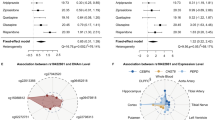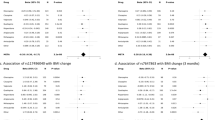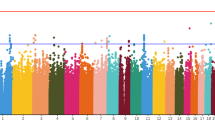Abstract
Understanding individual differences in the susceptibility to metabolic side effects as a response to antipsychotic therapy is essential to optimize the treatment of schizophrenia. Here, we perform genomewide association studies (GWAS) to search for genetic variation affecting the susceptibility to metabolic side effects. The analysis sample consisted of 738 schizophrenia patients, successfully genotyped for 492K single nucleotide polymorphisms (SNPs), from the genomic subsample of the Clinical Antipsychotic Trial of Intervention Effectiveness study. Outcomes included 12 indicators of metabolic side effects, quantifying antipsychotic-induced change in weight, blood lipids, glucose and hemoglobin A1c, blood pressure and heart rate. Our criterion for genomewide significance was a pre-specified threshold that ensures, on average, only 10% of the significant findings are false discoveries. A total of 21 SNPs satisfied this criterion. The top finding indicated that a SNP in Meis homeobox 2 (MEIS2) mediated the effects of risperidone on hip circumference (q=0.004). The same SNP was also found to mediate risperidone's effect on waist circumference (q=0.055). Genomewide significant finding were also found for SNPs in PRKAR2B, GPR98, FHOD3, RNF144A, ASTN2, SOX5 and ATF7IP2, as well as in several intergenic markers. PRKAR2B and MEIS2 both have previous research indicating metabolic involvement, and PRKAR2B has previously been shown to mediate antipsychotic response. Although our findings require replication and functional validation, this study shows the potential of GWAS to discover genes and pathways that potentially mediate adverse effects of antipsychotic medication.
This is a preview of subscription content, access via your institution
Access options
Subscribe to this journal
Receive 12 print issues and online access
$259.00 per year
only $21.58 per issue
Buy this article
- Purchase on Springer Link
- Instant access to full article PDF
Prices may be subject to local taxes which are calculated during checkout

Similar content being viewed by others
References
Kane JM, Marder SR . Psychopharmacologic treatment of schizophrenia. Schizophr Bull 1993; 19: 287–302.
Kane JM, McGlashan TH . Treatment of schizophrenia. Lancet 1995; 346: 820–825.
Correll CU, Schenk EM . Tardive dyskinesia and new antipsychotics. Curr Opin Psychiatry 2008; 21: 151–156.
Kane JM, Woerner M, Weinhold P, Kinon B, Lieberman J, Wegner J . Epidemiology of tardive dyskinesia. Clin Neuropharmacol 1983; 6: 109–115.
Pickar D, Litman RE, Hong WW, Su TP, Weissman EM, Hsiao JK et al. Clinical response to clozapine in patients with schizophrenia. Arch Gen Psychiatry 1994; 51: 159–160.
Pickar D, Hsiao JK . Clozapine treatment of schizophrenia. JAMA 1995; 274: 981–983.
Pickar D . Prospects for pharmacotherapy of schizophrenia. Lancet 1995; 345: 557–562.
Kinon BJ, Lieberman JA . Mechanisms of action of atypical antipsychotic drugs: a critical analysis. Psychopharmacology (Berl) 1996; 124: 2–34.
Leucht S, Corves C, Arbter D, Engel RR, Li C, Davis JM . Second-generation versus first-generation antipsychotic drugs for schizophrenia: a meta-analysis. Lancet 2009; 373: 31–41.
Meyer JM, Davis VG, Goff DC, McEvoy JP, Nasrallah HA, Davis SM et al. Change in metabolic syndrome parameters with antipsychotic treatment in the CATIE Schizophrenia Trial: prospective data from phase 1. Schizophr Res 2008; 101: 273–286.
Henderson DC, Doraiswamy PM . Prolactin-related and metabolic adverse effects of atypical antipsychotic agents. J Clin Psychiatry 2008; 69 (Suppl 1): 32–44.
Bellack AS . Scientific and consumer models of recovery in schizophrenia: concordance, contrasts, and implications. Schizophr Bull 2006; 32: 432–442.
Gunes A, Melkersson KI, Scordo MG, Dahl ML . Association between HTR2C and HTR2A polymorphisms and metabolic abnormalities in patients treated with olanzapine or clozapine. J Clin Psychopharmacol 2009; 29: 65–68.
Barnes NM, Sharp T . A review of central 5-HT receptors and their function. Neuropharmacology 1999; 38: 1083–1152.
Meltzer HY . Treatment of schizophrenia and spectrum disorders: pharmacotherapy, psychosocial treatments, and neurotransmitter interactions. Biol Psychiatry 1999; 46: 1321–1327.
Matsui-Sakata A, Ohtani H, Sawada Y . Receptor occupancy-based analysis of the contributions of various receptors to antipsychotics-induced weight gain and diabetes mellitus. Drug Metab Pharmacokinet 2005; 20: 368–378.
Malhotra AK, Murphy Jr GM, Kennedy JL . Pharmacogenetics of psychotropic drug response. Am J Psychiatry 2004; 161: 780–796.
Altshuler D, Daly MJ, Lander ES . Genetic mapping in human disease. Science 2008; 322: 881–888.
Byun E, Caillier SJ, Montalban X, Villoslada P, Fernández O, Brassat D et al. Genome-wide pharmacogenomic analysis of the response to interferon beta therapy in multiple sclerosis. Arch Neurol 2008; 65: 337–344.
Lavedan C, Licamele L, Volpi S, Hamilton J, Heaton C, Mack K et al. Association of the NPAS3 gene and five other loci with response to the antipsychotic iloperidone identified in a whole genome association study. Mol Psychiatry 2009; 14: 804–819.
Link E, Parish S, Armitage J, Bowman L, Heath S, Matsuda F et al. SLCO1B1 variants and statin-induced myopathy--a genomewide study. N Engl J Med 2008; 359: 789–799.
Liu C, Batliwalla F, Li W, Lee A, Roubenoff R, Beckman E et al. Genome-wide association scan identifies candidate polymorphisms associated with differential response to anti-TNF treatment in rheumatoid arthritis. Mol Med 2008; 14: 575–581.
Stroup TS, McEvoy JP, Swartz MS, Byerly MJ, Glick ID, Canive JM et al. The National Institute of Mental Health Clinical Antipsychotic Trials of Intervention Effectiveness (CATIE) project: schizophrenia trial design and protocol development. Schizophr Bull 2003; 29: 15–31.
Lieberman JA, Stroup TS, Mcevoy JP, Swartz MS, Rosenheck RA, Perkins DO et al. Effectiveness of antipsychotic drugs in patients with chronic schizophrenia. N Engl J Med 2005; 353: 1209–1223.
Sullivan PF, Lin D, Tzeng JY, van den Oord E, Perkins D, Stroup TS et al. Genomewide association for schizophrenia in the CATIE study: results of stage 1. Mol Psychiatry 2008; 13: 570–584.
First M, Spitzer R, Gibbon M, Williams J . Structured Clinical Interview for DSM-IV Axis I Disorders—Administration Booklet. American Psychiatric Press: Washington DC, 1994.
Mcevoy JP, Meyer JM, Goff DC, Nasrallah HA, Davis SM, Sullivan L et al. Prevalence of the metabolic syndrome in patients with schizophrenia: baseline results from the Clinical Antipsychotic Trials of Intervention Effectiveness (CATIE) schizophrenia trial and comparison with national estimates from III NHANES. Schizophr Res 2005; 80: 19–32.
Van den Oord EJCG, Adkins DE, McClay J, Lieberman J, Sullivan PF . A systematic method for estimating individual responses to treatment with antipsychotics in CATIE. Schizophr Res 2009; 107: 13–21.
Goldstein H . Multilevel Statistical Models. Arnold: London, 1995.
Searle SR, Casella G, McCulloch CE . Variance Components. Wiley: New York, 1992.
Pinheiro JC, Bates DM . Mixed-Effects Models in S and S-plus. Springer: NY, New York, 2000.
Purcell S, Neale B, Todd-Brown K, Thomas L, Ferreira MA, Bender D et al. PLINK: A tool set for whole-genome association and population-based linkage analyses. Am J Hum Genet 2007; 81: 559–575.
Van den Oord EJCG, Sullivan PF . False discoveries and models for gene discovery. Trends Genet 2003; 19: 537–542.
Benjamini Y, Hochberg Y . Controlling the false discovery rate: A practical and powerful approach to multiple testing. J R Stat Soc B 1995; 57: 289–300.
Storey J . The positive false discovery rate: a Bayesian interpretation and the q-value. Ann Stat 2003; 31: 2013–2035.
Brown BW, Russell K . Methods of correcting for multiple testing: operating characteristics. Stat Med 1997; 16: 2511–2528.
Fernando RL, Nettleton D, Southey BR, Dekkers JC, Rothschild MF, Soller M . Controlling the proportion of false positives in multiple dependent tests. Genetics 2004; 166: 611–619.
Van den Oord EJCG, Sullivan PF . A framework for controlling false discovery rates and minimizing the amount of genotyping in the search for disease mutations. Hum Hered 2003; 56: 188–199.
Korn EL, Troendle J, McShane L, Simon R . Controlling the number of false discoveries: Application to high-dimensional genomic data. J Stat Plan Inference 2004; 124: 379–398.
Tsai CA, Hsueh HM, Chen JJ . Estimation of false discovery rates in multiple testing: application to gene microarray data. Biometrics 2003; 59: 1071–1081.
Van den Oord EJCG . Controlling false discoveries in candidate gene studies. Mol Psychiatry 2005; 10: 230–231.
Sabatti C, Service S, Freimer N . False discovery rate in linkage and association genome screens for complex disorders. Genetics 2003; 164: 829–833.
Storey J, Tibshirani R . Statistical significance for genome-wide studies. Proc Natl Acad Sci 2003; 100: 9440–9445.
Bukszar J, McClay JL, van den Oord EJ . Estimating the posterior probability that genomewide association findings are true or false. Bioinformatics 2009; 25: 1807–1813.
Glonek G, Soloman P . Discussion of resampling-based multiple testing for microarray data analysis by Ge, Dudoit and Speed. Test 2003; 12: 1–77.
Moens CB, Selleri L . Hox cofactors in vertebrate development. Dev Biol 2006; 291: 193–206.
Yang Y, Hwang CK, D’Souza UM, Lee SH, Junn E, Mouradian MM . Three-amino acid extension loop homeodomain proteins Meis2 and TGIF differentially regulate transcription. J Biol Chem 2000; 275: 20734–20741.
Smith JE, Afonja O, Yee HT, Inghirami G, Takeshita K . Chromosomal mapping to 15q14 and expression analysis of the human MEIS2 homeobox gene. Mamm Genome 1997; 8: 951–952.
Hui H, Perfetti R . Pancreas duodenum homeobox-1 regulates pancreas development during embryogenesis and islet cell function in adulthood. Eur J Endocrinol 2002; 146: 129–141.
Swift GH, Liu Y, Rose SD, Bischof LJ, Steelman S, Buchberg AM et al. An endocrine-exocrine switch in the activity of the pancreatic homeodomain protein PDX1 through formation of a trimeric complex with PBX1b and MRG1 (MEIS2). Mol Cell Biol 1998; 18: 5109–5120.
Liu Y, MacDonald RJ, Swift GH . DNA binding and transcriptional activation by a PDX1.PBX1b.MEIS2b trimer and cooperation with a pancreas-specific basic helix-loop-helix complex. J Biol Chem 2001; 276: 17985–17993.
Nikkila H, McMillan DR, Nunez BS, Pascoe L, Curnow KM, White PC . Sequence similarities between a novel putative G protein-coupled receptor and Na+/Ca2+ exchangers define a cation binding domain. Mol Endocrinol 2000; 14: 1351–1364.
McMillan DR, Kayes-Wandover KM, Richardson JA, White PC . Very large G protein-coupled receptor-1, the largest known cell surface protein, is highly expressed in the developing central nervous system. J Biol Chem 2002; 277: 785–792.
Scheel H, Tomiuk S, Hofmann K . A common protein interaction domain links two recently identified epilepsy genes. Hum Mol Genet 2002; 11: 1757–1762.
Weston MD, Luijendijk MW, Humphrey KD, Moller C, Kimberling WJ . Mutations in the VLGR1 gene implicate G-protein signaling in the pathogenesis of Usher syndrome type II. Am J Hum Genet 2004; 74: 357–366.
Levy FO, Oyen O, Sandberg M, Taskén K, Eskild W, Hansson V et al. Molecular cloning, complementary deoxyribonucleic acid structure and predicted full-length amino acid sequence of the hormone-inducible regulatory subunit of 3′-5′-cyclic adenosine monophosphate-dependent protein kinase from human testis. Mol Endocrinol 1988; 2: 1364–1373.
Cummings DE, Brandon EP, Planas JV, Motamed K, Idzerda RL, McKnight GS . Genetically lean mice result from targeted disruption of the RII beta subunit of protein kinase A. Nature 1996; 382: 622–626.
Czyzyk TA, Sikorski MA, Yang L, McKnight GS . Disruption of the RIIbeta subunit of PKA reverses the obesity syndrome of Agouti lethal yellow mice. Proc Natl Acad Sci USA 2008; 105: 276–281.
Porcellini A, Messina S, De Gregorio G, Feliciello A, Carlucci A, Barone M et al. The expression of the thyroid-stimulating hormone (TSH) receptor and the cAMP-dependent protein kinase RII beta regulatory subunit confers TSH-cAMP-dependent growth to mouse fibroblasts. J Biol Chem 2003; 278: 40621–40630.
Konneker T, Barnes T, Furberg H, Losh M, Bulik CM, Sullivan PF . A searchable database of genetic evidence for psychiatric disorders. Am J Med Genet B Neuropsychiatr Genet 2008; 147B: 671–675.
Schadt EE, Molony C, Chudin E, Hao K, Yang X, Lum PY et al. Mapping the genetic architecture of gene expression in human liver. PLoS Biol 2008; 6: e107.
Adams MR, Brandon EP, Chartoff EH, Idzerda RL, Dorsa DM, McKnight GS . Loss of haloperidol induced gene expression and catalepsy in protein kinase A-deficient mice. Proc Natl Acad Sci USA 1997; 94: 12157–12161.
Kanaya H, Takeya R, Takeuchi K, Watanabe N, Jing N, Sumimoto H . Fhos2, a novel formin-related actin-organizing protein, probably associates with the nestin intermediate filament. Genes Cells 2005; 10: 665–678.
Arranz MJ, de Leon J . Pharmacogenetics and pharmacogenomics of schizophrenia: a review of last decade of research. Mol Psychiatry 2007; 12: 707–747.
Need AC, Keefe RS, Ge D, Grossman I, Dickson S, McEvoy JP et al. Pharmacogenetics of antipsychotic response in the CATIE trial: a candidate gene analysis. Eur J Hum Genet 2009; 17: 946–957.
Le Hellard S, Theisen FM, Haberhausen M, Raeder MB, Fernø J, Gebhardt S et al. Association between the insulin-induced gene 2 (INSIG2) and weight gain in a German sample of antipsychotic-treated schizophrenic patients: perturbation of SREBP-controlled lipogenesis in drug-related metabolic adverse effects? Mol Psychiatry 2009; 14: 308–317.
Choquet H, Cavalcanti-Proenca C, Lecoeur C, Dina C, Cauchi S, Vaxillaire M et al. The T-381C SNP in BNP gene may be modestly associated with type 2 diabetes: an updated meta-analysis in 49 279 subjects. Hum Mol Genet 2009; 18: 2495–2501.
Lindgren CM, Heid IM, Randall JC, Lamina C, Steinthorsdottir V, Qi L et al. Genome-wide association scan meta-analysis identifies three Loci influencing adiposity and fat distribution. PLoS Genet 2009; 5: e1000508.
Prokopenko I, Langenberg C, Florez JC, Saxena R, Soranzo N, Thorleifsson G et al. Variants in MTNR1B influence fasting glucose levels. Nat Genet 2009; 41: 77–81.
Sandhu MS, Waterworth DM, Debenham SL, Wheeler E, Papadakis K, Zhao JH et al. LDL-cholesterol concentrations: a genome-wide association study. Lancet 2008; 371: 483–491.
Wallace C, Newhouse SJ, Braund P, Zhang F, Tobin M, Falchi M et al. Genome-wide association study identifies genes for biomarkers of cardiovascular disease: serum urate and dyslipidemia. Am J Hum Genet 2008; 82: 139–149.
Willer CJ, Sanna S, Jackson AU, Scuteri A, Bonnycastle LL, Clarke R et al. Newly identified loci that influence lipid concentrations and risk of coronary artery disease. Nat Genet 2008; 40: 161–169.
Willer CJ, Speliotes EK, Loos RJ, Li S, Lindgren CM, Heid IM et al. Six new loci associated with body mass index highlight a neuronal influence on body weight regulation. Nat Genet 2009; 41: 25–34.
Acknowledgements
The CATIE project was supported by NIMH contract N01 MH90001. Dr Sullivan was supported by R01s MH074027 and MH077139 and Dr van den Oord was supported by R01s MH078069 and HG004240.
Author information
Authors and Affiliations
Corresponding author
Additional information
Supplementary Information accompanies the paper on the Molecular Psychiatry website (http://www.nature.com/mp)
Supplementary information
Rights and permissions
About this article
Cite this article
Adkins, D., Åberg, K., McClay, J. et al. Genomewide pharmacogenomic study of metabolic side effects to antipsychotic drugs. Mol Psychiatry 16, 321–332 (2011). https://doi.org/10.1038/mp.2010.14
Received:
Revised:
Accepted:
Published:
Issue Date:
DOI: https://doi.org/10.1038/mp.2010.14
Keywords
This article is cited by
-
Current Update on Categorization of Migraine Subtypes on the Basis of Genetic Variation: a Systematic Review
Molecular Neurobiology (2023)
-
Systems-Level Analysis of Genetic Variants Reveals Functional and Spatiotemporal Context in Treatment-resistant Schizophrenia
Molecular Neurobiology (2022)
-
Delineating significant genome-wide associations of variants with antipsychotic and antidepressant treatment response: implications for clinical pharmacogenomics
Human Genomics (2020)
-
Genomewide Gene-by-Sex Interaction Scans Identify ADGRV1 for Sex Differences in Opioid Dependent African Americans
Scientific Reports (2019)
-
Pharmakogenetik in der Psychiatrie: eine Standortbestimmung
Der Nervenarzt (2018)



